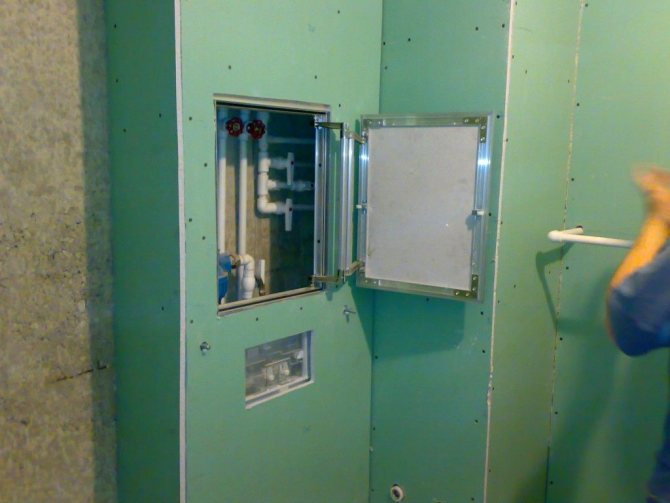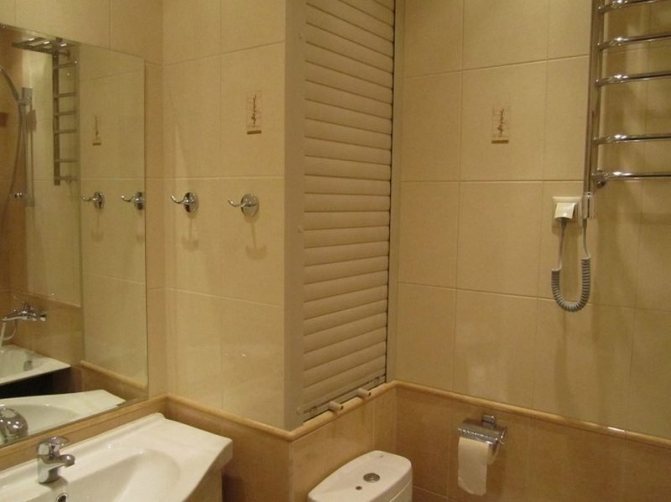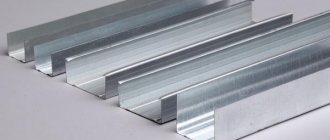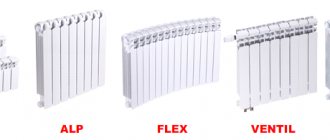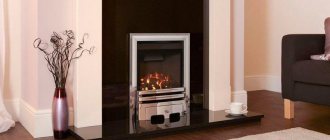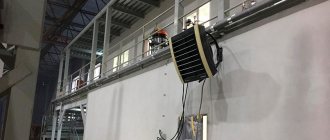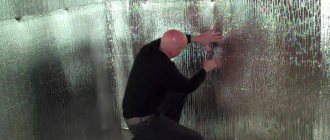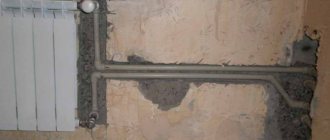
Communications laid on the walls are unlikely to decorate the interior of the bathroom.
To disguise them, use a pipe box in the bathroom, which you can make yourself.
- Working with PVC panels
How to hide communications
The wiring in the bathroom includes pipes connected to various plumbing devices (bath, washbasin, and with a combined bathroom and to the toilet), as well as various appliances and devices: valves, filters, water meters.
So that communication systems are not conspicuous, they are hidden using various methods.
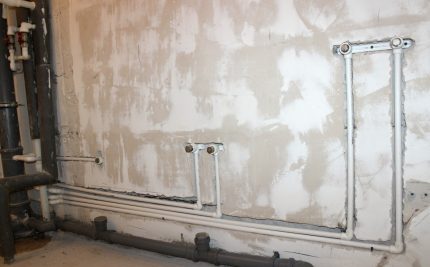

When organizing hidden wiring, pipes are hidden in specially chiselled channels in the walls. Please note that this method has many limitations.
One of them is hidden wiring. In this case, the pipes are hidden inside the walls, arranging special grooves-grooves in the latter. However, this method is not universal as it has a number of limitations:
- wall chasing is possible only during major repairs, since in this case, complete elimination of finishing coatings and replacement of communication equipment are required;
- when installing hidden wiring, it is impossible to hide a filter, meter or other device;
- building codes prohibit punching grooves in load-bearing structures, since they sharply reduce the strength of the walls;
- there are restrictions on the dimensional characteristics of pipes that are used for hidden wiring: their diameter should not exceed 50 mm. Therefore, this method is in no way suitable for masking a thick sewer pipe;
- this method is not suitable for risers, the appearance of which is unlikely to decorate the interior of the bathroom.
An alternative to hidden wiring is a combined system that provides for the device of a box on the surface of the walls. In this case, the pipes are placed in a specially allocated space, and the outer walls are finished in accordance with the interior style.
Plastic decorative boxes for heating pipes
Pros:
- the most affordable boxes and decorative screens (grilles),
- practical in service,
- do not need painting,
- universal for gas, sewer and cold water pipes.
Due to the popularity of such boxes, manufacturers often use low-quality plastic. Not withstand prolonged exposure to high temperatures (hot water supply, heating pipes). As a result, the decorative box:
- deformed,
- changes color,
- become fragile.
A plastic box in the form of a plinth deserves special attention. But it already belongs to a different, higher price category.
Advantages of a camouflage box
In the design of modern bathrooms, such structures are often used, masking one or several pipes, since boxes have a number of undeniable advantages.
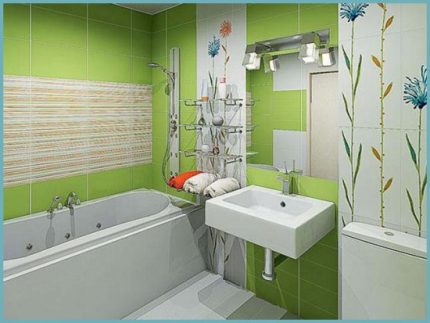

A box for pipes made of plastic panels or drywall will improve the interior of the bathroom. This design will successfully fit into any room.
Such constructions are typical:
- Neat appearance, which is achieved by using quality materials for the manufacture and design of the structure.
- Ease of installation.The system can be performed not only for major, but also for cosmetic repairs, since the box can be installed even over the finished finish.
- Providing easy access to the pipeline, which allows not only taking meter readings, but also monitoring the condition of the pipes, and, if necessary, repairing devices and communications.
- The possibility of combining the box with the toilet installation, shelves and other details, thus achieving optimal use of the area of even a small room.
A carefully executed and finished box can become a real decoration of the bathroom, combining functionality and aesthetics.
Sheathing and facing of the box


Tiled box
Sheathing the box is also a fairly simple task, since all the necessary markings have been completed long ago, it remains only to cut the material for the sheathing correctly and attach it to the frame.
For cladding, a material that is resistant to moisture should be used, since the bathroom is a room with high humidity, which significantly reduces the service life of many materials.
The most preferred materials for sheathing the box are fiberboard, plywood and drywall, which are resistant to moisture and differ in a rather simple installation procedure - self-tapping screws can be used to fasten any of the three listed materials to the frame.
Important: the box must also be insulated and sealed to prevent the accumulation of condensate on the pipes. For sealing, polyurethane foam can be used, as well as various heat insulators and sealants.
As you can see from the article, it is quite simple to close the pipes in the bathroom with the help of a box - the main thing is only to choose the right material, carefully perform all the necessary measurements and apply markings. In addition, the video on the installation of the box attached to the article can facilitate the task.
Did you like the article? Subscribe to our channel Yandex.Zen
Choosing building materials for installation
To make a box, you must first build a frame, which is then covered with a cladding material, and often also additionally finished, for example, covered with tiles.
The base is made of galvanized metal guides (vertical and horizontal). As a coating, various types of building materials can be used, which must have a number of qualities, namely:
- Moisture resistance. Boxes are arranged in bathrooms, which contain an increased percentage of water vapor.
- Light in weight and light in thickness. Both the ease of installation and the dimensions of the finished structure depend on these factors: too dense walls can "take away" a significant part of the space.
- Environmentally friendly. Such constructions should not emit toxic substances or have a pronounced allergenic effect.
- Aesthetic appearance or the possibility of additional finishing.
Most often, the following types of materials are used for cladding.
Option # 1: plastic panels (PVC)
Polymer panels have a beautiful appearance. They are available in a large assortment, which allows you to choose a finishing material that perfectly matches the color palette of the bathroom.


In the assortment of building stores, you can find plastic panels of various colors and shades. In addition to its beautiful appearance, this material is also strong and durable.
In addition to aesthetics, PVC panels have high consumer qualities:
- perfect water resistance;
- resistance to deformation and mechanical damage;
- durability: flexible and durable plastic can serve for many years;
- ease of care - it is enough to simply wipe dirty parts with a damp cloth;
- ease of installation: working with this material does not require special professional skills and special equipment;
- availability: PVC panels - a budget finishing material that has a low cost;
- the possibility of quick repair: damaged structural elements can be removed without destroying the entire box;
- compactness. The panels have a small thickness, so the structures built from them do not take up much space, which is extremely important for miniature rooms.
Plasterboard, which is widely used in construction, is usually an alternative to plastic panels.
Option # 2: moisture resistant plasterboard
There are various varieties of this popular material. To decorate the bathroom, do not use standard drywall (GKL), intended for rooms where moderate humidity reigns (up to 70%).


Moisture-resistant gypsum plasterboard sheets are often used for the construction of boxes. This inexpensive material is easy to install; it also has good resistance to water vapor
At the same time, a moisture-resistant type of drywall - GKVL, which is easy to recognize by the green surface of the plates, is well suited for finishing the plumbing unit. Such sheets are suitable for both standard facing work and for creating complex structures with convex, concave and curved surfaces (in this case, however, working with drywall requires special skills).
Another additional advantage of GKVL is the impregnation of the plates with antifungal drugs that prevent the development of harmful mold.
At the same time, when choosing a material, you should take into account some of the features of drywall:
- Installation of structures made of gypsum board or gypsum plasterboard requires more effort than installing systems made of plastic or MDF boards.
- It will not be possible to make a collapsible structure from drywall, therefore, when making a box, it is imperative to provide for a door or hatch that provides access to valves, meters and other elements of the communication system.
- Plates GKL (GKVL) are not a finishing material: making a box from them, it is important to think over the finish. Taking into account the high humidity in bathrooms, the paneling with tiles is usually used, but other types of decoration can also be used: paint, decorative plaster, wallpaper.
It is important to note that experts advise to additionally impregnate even moisture-resistant plates with a special composition in order to increase the strength and resistance of the element to moisture.
In addition, you can build a box from other materials.
Option # 3: waterproof plywood
This modification differs from ordinary plywood in the special composition of the glue used. The sheets have a thickness of 6 to 40 millimeters and have fairly good consumer properties, however, despite the name, it is better to additionally process them with special compounds that improve water resistance. The main disadvantage of waterproof plywood is its high cost, because of which it is used less often than other building materials.
Option # 4: MDF and HDF boards
Sometimes you can find tips for using boxes made of MDF panels (Medium Density Fibreboard). It is hardly worth following such recommendations, since this material absorbs water vapor well and is not very suitable for wet rooms.
It is much more expedient to cover the structure with HDF sheets (High Density Fiberbord). This material resists moisture well, so that the structures made of it do not lose their properties for 10 or more years.
Option # 5: OSB boards
Another suitable coating option can be oriented strand boards (OSB, OSB, Oriented Strand Board) - multilayer sheets glued with resins, into which synthetic wax and other additives are added.
There are several varieties of this material. For the manufacture of boxes, it is best to stay on OSB3 sheets (with additional impregnation), as well as on OSB4 sheets. The latter can be used for particularly strong structures or in places where a large load falls.
Choosing the optimal design
Pipe fencing can be done in many ways and the most common configurations are as follows.
Boxes-cabinets... This option is usually provided for risers and other vertical systems. The design provides full access to communications. Plus, it can be easily combined with shelves and other fixtures to make the most of your floor space.
Partition boxes... These structures are installed over the entire width and height of the room, practically isolating a certain part. Although in this case the area of the bathroom is somewhat reduced, the room looks very neat, since all communication systems are masked.
This option is especially suitable for spacious baths. It can also be advised when using a wall-hung toilet, since the partition, along with the communication systems, allows you to hide the installation. Behind the partition, you can also place devices for storing necessary things, for example, household chemicals.
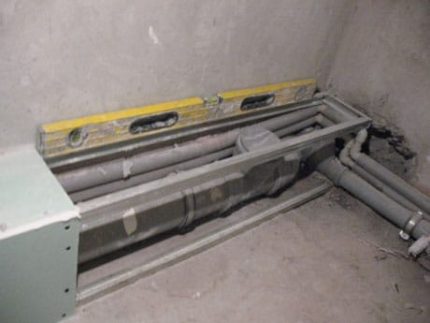

In addition to vertical systems, horizontal ducts are very popular, which allow you to mask pipes adjacent to the floor or ceiling.
Compact boxbuilt around pipes. The most commonly used construction, which practically does not absorb space, but gives the interior a neat look. Such systems can be both vertical and horizontal, adjacent to the floor or ceiling.
Below we will analyze in detail the stages of manufacturing such a design.
Manufacturing
Step 1. Sizing
Before installing the box, you should clarify the location of its placement and determine the geometric parameters. If the box is made non-removable, then for access to metering devices and cranes, it is necessary to install inspection doors. When measuring, do not forget about the thickness of the material used and the decorative finish.
Advice! Before making the box, it is advisable to draw a sketch where all its details will be indicated in the selected scale, as well as dimensions. This will help both when purchasing the right amount of materials and when assembling the product on site.
The marking of the installation site starts from the floor. Remember that the distance from the pipeline to the edges of the protective box should be at least 3 cm. After that, the dimensions are transferred using a plumb line or a laser level to the walls and other surfaces of the bathroom.


Before installing the box, you should carefully consider the markup
Stage 2. Installation of the frame
Before installing the cladding, it is necessary to mount the support frame. For its manufacture, it is best to use a galvanized profile. Some craftsmen make a frame from wood, but this is undesirable, since the wood gradually collapses under the influence of moisture in the air.
As a last resort, choose hardwood lumber, and treat parts with antiseptic compounds to prevent the occurrence of mold and mildew.
The constituent elements of the frame are connected to each other using self-tapping screws, and are attached to the wall using dowels or anchor bolts.
The entire manufacturing process consists of several sequential stages:
- First of all, the aluminum profile or wooden planks are fixed to the wall.... The marks made at the preparatory stage serve as a guide.
- After that, the front edge is fixed... Its installation is carried out using corners that are screwed to the floor or ceiling.
- Then the floor and ceiling rails are installed. (planks between the wall and front profile).
- If the length of the box exceeds 150 cm, it is necessary to additionally make jumpers... They will also be required if the width of the side edge exceeds 25 cm.The distance between adjacent elements should not be more than 100 cm.
A ready-made frame for a box made of an aluminum profile
Advice! If wooden blocks were used for the frame, the sawing points should be treated with construction mastic. This will protect the structure from rotting.
Step 3. Sheathing
It is better to sheathe the finished frame with solid parts. The use of chunks is not recommended. Work should start from the side edges. Cutting is done so that the side edges of the parts do not protrude beyond the edges of the frame.
After that, the front part is cut out. It should cover the end cuts of the sidewalls. Fastening is done with self-tapping screws. The distance between them should not exceed 2-3 cm.
This allows for maximum structural strength. The screws only need to be screwed into the main rails of the rack; it is not necessary to fasten the sheathing sheets to the transverse elements.
To provide access to meters and valves, it is necessary to provide inspection holes with doors. It is better to buy them in the store, but you can also make them yourself. In the latter case, the material is used that was also used for the cladding.
You can hang the door using the piano hinges. To prevent it from opening, screw on a regular furniture magnet.


Box in the bathroom, sheathed with moisture-resistant plasterboard
If you decide to make a collapsible box, the sheets of finishing material are fixed with self-tapping screws to the very edge and are not covered with decorative trim. Then plastic corners and baseboards are installed, which will give the structure strength. If dismantling is necessary, these parts are removed, the screws are unscrewed and the cladding material is removed.
Step 4. Decorative finishing
The choice of material for decoration depends on what was used to make the structure itself. Plywood or MDF can be plastered and painted or covered with ceramic tiles.
The plastic itself has an excellent appearance, therefore it does not require additional finishing.


Finished box tiled
Preparing to install the box
Before starting the construction of the structure, preliminary work should be carried out.
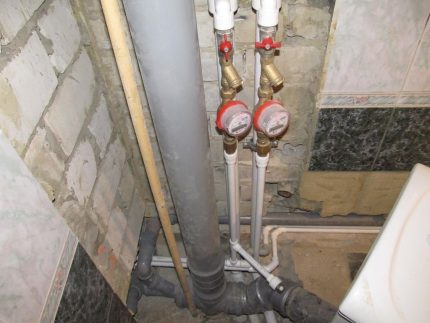

Before starting work on the manufacture of the box, you should make sure of the reliability of pipes and other elements by checking all communications for leaks and hidden defects
If a new pipeline is being laid, it is advisable to provide a minimum number of connections in it.
Then choose the project of the box, which would be best suited for the bathroom, take all the necessary measurements, and then draw up a sketch-drawing of the structure. In this case, it is imperative to provide access to devices and devices (filters, valves).
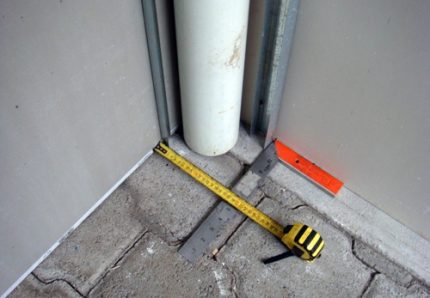

Before starting the manufacture of the box, it is important to carefully measure the distance, and then make a calculation, finding out the required number of profiles, PVC panels and other materials
According to the drawn diagram, the required amount of building materials should be calculated, providing a small margin.
It is also important to stock up on all the necessary equipment in advance, as well as purchase panels, guides and other necessary structural elements. They need to be carefully examined in order to identify chips, defects and damage in time.
Required tools and materials
For the construction of the box, you will need the following devices:
- well sharpened construction knife;
- roulette;
- scissors for metal;
- level or square;
- screwdriver or screwdriver;
- pencil;
- fasteners (self-tapping screws, euro screws, dowels);
- drill or hammer drill.
From the materials you should purchase:
- galvanized metal profiles (types ud, cd);
- silicone sealant;
- GVKL, HDF, OSB or plastic panels (in the latter case, it is important to choose a shade that matches the color palette of the interior);
- PVC skirting boards designed for masking joints with walls.
You may also need putty and corners to prepare the drywall box for additional finishing.
Choosing a pipe box in the bathroom
Before starting the installation of the box, it is necessary to think over the device of the box, taking into account that access to the pipes may be required.
In the event of a breakdown, leakage and the need to replace pipes, the box should not interfere, and at the same time, access to the pipes did not require a complete dismantling of the structure.


Tile is perfect as a finishing material for the box.
If the installation of the box is carried out independently, then it is necessary to remember the main stages of work, which will significantly increase the quality of the product and allow the structure to be durable. A strong material is chosen as the basis of the frame, as a rule, it is a rail or a profile made of aluminum. Before making a frame, measurements of communications are carried out, which must be hidden and calculations.
After the calculations, you can proceed directly to the assembly of the frame.
The slats are fastened to the wall with self-tapping screws, you can pre-fix wooden beams at the junction with the wall.
After the frame is assembled and installed, you can proceed to the cladding. There are several cladding options. It is advisable to finish finishing from the same material as the walls in the bathroom, however, there may be other options at the discretion of the owner.
Drywall is the most popular for cladding, as this material lends itself to work even for beginners. Its surface is ready for decorative finishing with any material.
Procedure:
- Before the material is cut out, measurements and calculations are carried out.
- After that, installation to the frame is carried out with self-tapping screws.
- After fixing, all seams are rubbed with a special putty.
- Next, a finishing decorative finish is carried out.
It is necessary to consider what materials are used, and whether additional coating is required for drywall. The joint with the wall is closed with a decorative skirting board.
The cladding with polystyrene panels does not require a frame. These panels have special legs that can be adjusted to the required dimensions. And the panels are connected with glue.
Ceramic tiles are popular due to their strength and moisture resistance, while cleaning such tiles is very easy. The facing of the box is carried out on a pre-installed drywall box.
Frame installation instructions
Regardless of what type of coating provides for the project of the box, first of all, a metal frame should be installed. For this, it is important to adhere to the following regulations. Work should start from the walls adjacent to the corner.
First of all, you need to make markings on vertical and horizontal surfaces.
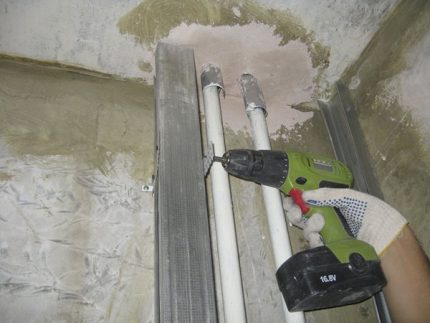

The first stage in creating a box for pipes is the installation of vertical guides, which are mounted on both sides of the corner or from communications
After that, you should install the guides (ud profile), which set the dimensions of the box. To attach them to the surface, you can use euro screws (dowels), drilling holes in the appropriate places with a drill. For walls lined with tiles, self-tapping screws "flea" (length 2.5 mm, diameter 3.5 mm), which can be screwed into the tile joints, are well suited.
If the pipes run horizontally, it is enough to spread the guides parallel to the floor and fix them. After that, the outer corner should be formed by twisting the corner post from two ud profiles. Their shelves must be directed at right angles in different directions, and then connected with small screws.
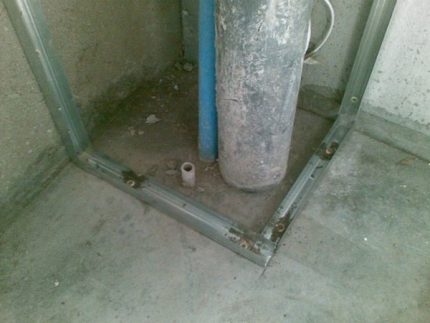

The vertical structure should be fixed to the floor and ceiling using horizontal elements that are fixed to horizontal surfaces
The cd support profile is cut with a knife into pieces, the dimensions of which correspond to the width and length of the box. The first corner rib is attached to the vertical surface, which determines the stiffness.The resulting sections of the profile are inserted with one end into the installed guide, and with the other into the stiffener, so that the parts of the corner would be connected to the profile.
At a certain distance, which can vary from 30 to 70 cm, jumpers should be added - they give the system strength and reliability, and are also used for hanging panels.
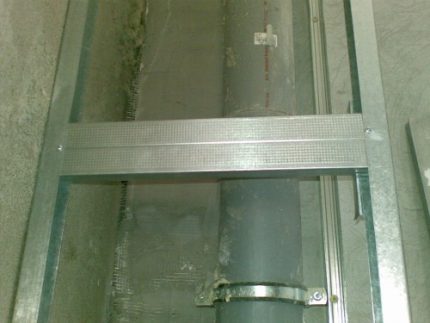

The finished frame of the box for pipes combines vertical guides and horizontal lintels, which give rigidity to the structure. It is also important to provide space for a door or hatch.
Having completed the work on one side, the second corner profile is attached to the other wall in the same way, after which the work on creating the frame of the box is considered complete.
What you need to know before installation
The interior of the bathroom is often spoiled by pipes, without which it, of course, would not be able to perform its functions. In this case, there is only one way out - to make them as less noticeable as possible, while retaining the ability to access if necessary.
Tiled plasterboard pipe box.
The best option is to make a special box for pipes in the toilet. The configuration of such a box will depend on the location of the pipes: sometimes you can make a false wall or build a simple square box, but you also have to create complex structures from several elements located at different levels.
Before you make a box for pipes in the toilet, you need to consider that an accident can happen.
If you plan to hide the pipes completely and do not want to leave the door to access them, then it is better to first check everything and replace them with new ones so that you do not have to break the structure in case of a leak. But even with high reliability, materials that are easy to dismantle are chosen for such purposes.
In place of the slots there will be hatches for access to the main pipe assemblies.
Making a box in the toilet with your own hands is not so difficult. First you need to decide on the material. The most popular are drywall and plastic panels. Walls can also be finished with PVC panels.
Regardless of the material you choose, the initial stage will be the creation of a structure from a wooden bar or metal profile.
- It is necessary to make a markup, given that the walls of the box should be located at a distance of 5-10 centimeters from the pipes.
- The profile is attached to the walls with dowel-nails, using a perforator for this purpose.
- After that, levels are laid from them on the ceiling and floor, attaching them in a similar way.
- The creation of the frame is completed by attaching an angle profile, which is attached with fleas to the upper and lower, and then connected to the wall profiles with the help of additional pieces.
- The plasterboard box is installed in the toilet using self-tapping screws or plastic panels are screwed on.
In the first case, drywall must be marked and cut into pieces with which the frame will be sewn up. The process uses self-tapping screws 27 mm, which are screwed every 30 centimeters. Excess parts at the joints can be trimmed with a painting knife or a hacksaw.
Before you make a drywall box in the toilet, you need to take into account that it will cost more than in the case of panels. But its plus is that you can choose any finish option, including paints, wallpaper and tiles.
- The final cost of the work is highly dependent on the amount of drywall required, which, in turn, depends on the location of the pipes and the chosen configuration.
- The average price of a custom-made drywall box is close to 3000 rubles without finishing.
The cost of facing will depend on the material and area: for example, when choosing a tile - from 600 rubles per sq. M.
The option with drywall is also more labor-intensive than the box in the toilet made of PVC panels. The plating process is quite simple - the panels are attached with flea beetles to the horizontal profiles with self-tapping screws, as is the case with drywall.The cost of such cladding from specialists is close to 500 rubles per square meter.
PVC panel box with sanitary hatch
There is another option that is perfect for owners of small and cramped bathrooms - you can hide the pipes using blinds, which are sold in almost any store. The indisputable advantage of the method is that access to pipes and meters remains free. As an option - installation of roller shutters. The price for special plumbing shutters is approximately 3000 - 3500 rubles.
Toilet 1.2 sq.m. with a plasterboard box - repair estimate
- Toilet with pipes in a PVC box and a boiler in the closet
If you want to get a beautiful bathroom as a result of the renovation, then you will need to try not only with the choice of ceramic tiles and sanitary ware, but also with the preparation of the room itself.
For example, it is worth hiding not too beautiful pipes that are unlikely to fit into the design of the room. How to make a pipe box in the bathroom and what it can be made of, you will learn from this article.
[contents]
But what if you need to have access to pipes without problems at any time? And what if you don't want to make noisy repairs?
master-ok.at.ua
There are 2 solutions to this problem. We have already talked about one modern solution (using roller blinds). There is a second solution - with the help of plastic panels.
- - guide profile 27x28 mm.,
- - liquid Nails,
- - plastic panels (2 pcs.) For the size of the future box,
- - starting profile,
- - external collapsible plastic corner with a wide shelf,
- - a pencil with a tape measure.
Pipes left in plain sight are not the best addition to a bathroom interior. In order for the room to have a neat and complete look, communications must be hidden.
Moreover, it is advisable to do this in such a way as to have access to the pipe connections, valves, meters and filters. The optimal solution to this problem will be the manufacture of a box.
Consider how to make a pipe box in a bathroom from plastic panels.
We offer you to familiarize yourself with the device of a sewer pipe in a private house
The structure for masking pipes can be made of plastic or drywall. Each of these options is good in its own way, but from the point of view of practicality, the plastic box is in the lead. It has many undeniable advantages:
- The ability to quickly disassemble without damaging the material This property of a plastic structure is especially important for pipes joined with fittings and threaded connections, which are not immune to leaks. After the elimination of the breakdown or scheduled maintenance of the pipes, the box is easily assembled back.
- No need for further finishing. Plastic panels themselves are already a finishing decorative material, in contrast to drywall, which requires final processing.
- Resistance to deformation and ease of repair. The plastic used to make the panels is strong and flexible, so it is less likely to be damaged than tiles that can be accidentally broken. Even if one panel is damaged, it is easy to replace it with a new one without damaging the entire structure.
- Moisture resistance. PVC is not afraid of water, does not rot, nothing will happen to the box, even if it is installed close to the bath or it gets wet due to condensation formed on the pipes.
- Easy to install. The installation of the box will take only a few hours and does not require the use of expensive or specific tools.
- Affordable price. Plastic panels for bathrooms are one of the most inexpensive finishing materials.
- Spaciousness and compactness. Due to the small thickness of the panels, the plastic structure is very spacious and does not take up much extra space in the bathroom, which is especially important for a small room.
The plastic box is very practical: it can be disassembled and reassembled as many times as necessary.
Before proceeding with the assembly of the box, you need to carry out several preliminary measures.
- Examine all pipes that will be hidden. Eliminate defects while communications are visible. If a new pipeline is being installed along the way, try to keep the number of connections to a minimum.
- Decide what kind of tub will look like in the bathroom. It can hide only a small area where pipes pass, or take up a fairly large area. The advantage of the first option is in saving material and not having to sacrifice free space. When choosing a more voluminous modification, the additional space inside the structure can be adapted for storing things.
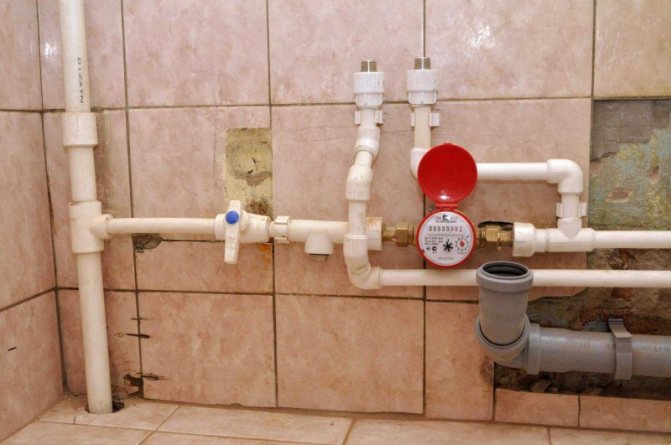

Tip: if you are going to lay out the walls with tiles, then it will be more convenient to make a box first. It will hide part of the floor, and you will not have to lay tiles in this place.
- Take the necessary measurements and make a drawing of the box. Consider important additional items at this stage, such as access doors to meters, valves, and loose connections.
- Calculate the amount of material needed with a small margin.
It will be more convenient to dock the panels horizontally. In the vertical version, to ensure the rigidity of the structure, it will be necessary to mount additional transverse strips of the frame every 40 cm.
To make a plastic box you will need:
- metal profiles for the frame type UD and CD;
- polymer panels;
- silicone sealant;
- PVC skirting boards for masking joints;
- inspection hatches-doors;
- self-tapping screws;
- sharp construction knife.
When installing the structure frame, follow the instructions below.
- On the walls adjacent to the corner, install guides (UD profiles) that will define the dimensions of the box. Don't forget to use the level. To fasten the bearing profiles to the wall, use euro screws and dowels. If the surface is tiled, you can take metal screws 2.5 centimeters long and 3.5 millimeters in diameter. They are twisted into the seams between the tiles.
Tip: To save space in the bathroom, install the profiles closer to the pipes. The minimum distance is 3 centimeters.
- If the pipes run horizontally, place the profile parallel to the floor and fix it to it.
- Start shaping the outside corner. Twist the corner post from the two UD profiles. Direct their shelves in different directions at right angles and connect with small screws - "flea".
USEFUL INFORMATION: How to put tiles on a wooden floor in a bathroom
- Cut the CD support profile into pieces that will fit the dimensions of the structure. Attach the corner stiffener to the wall. Insert the finished pieces of the profile with one end into the guide installed at the first stage, with the other into the stiffener. Thus, both parts of the corner are connected to the profile.
- Every 50 centimeters, add the jumpers, which are necessary for the subsequent fastening of the PVC panels.
- The second corner profile is attached in the same way to another wall.
After the supporting structure is ready, you can start in its sheathing. This should be done in the following sequence:
- Install the start profile. Carefully, avoiding deformation, secure it with the help of "flea beetles" on the installed rail.
- Measure a strip of plastic panel to the desired length, cut it off with a sharp knife.
- Fix one panel in the starting profile, attach the other to the corner profile and install it to the other plane of the box. To connect, use all the same "fleas" or "bugs".
- Assemble the second side of the box in the same way. Fix the starting profile on the last plastic panel, then secure it. If you do this with silicone, you can ensure that you can easily dismantle it in the future in the event of an emergency.
- Cut inspection holes in those places where you need unhindered access to important elements of the pipeline: taps, meters and joints. Using silicone sealant, fix the special hatches in the holes.
- The last stage will be the installation of plastic skirting boards at the joints of the panels with each other, as well as with the floor, walls and ceiling.
What do you need?
It is important that the plastic pipe box does not interfere with free access to communications, otherwise, in the event of force majeure situations, it will take precious minutes to ensure sufficient operational space.
Two options for sheathing the frame
Elements from a finishing material should be connected to the base. Let's consider the most common options, each of which has its own characteristics.
Working with PVC panels
This is one of the easiest ways to camouflage pipes.
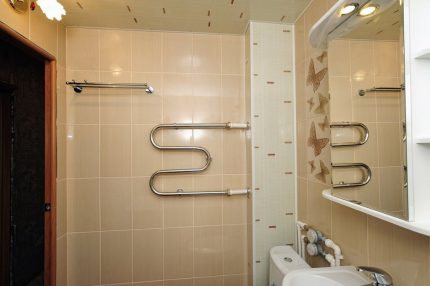

The box made of plastic panels has a collapsible design. If necessary, you can take out a loose part to gain access to pipes and other communication elements
Instructions for implementation:
- Install the starting profile, carefully fixing it with small screws on the installed guide part. Measure out a strip of plastic panel of the required size, then cut it off with a knife.
- Fix one panel in the starting profile, the other - fasten to the corner profile, after which the latter is installed to the other plane of the box. For fasteners, you can use "flea beetles" (small screws).
- The second side of the box is assembled in a similar way, while the starting profile is fixed and fixed on the last plastic panel, which is easiest to do with the help of silicone sealant.
- In places where it is necessary to provide access to important communication elements (taps, joints, meters), it is important to cut through the revision holes on which special hatches are fixed (with sealant or in other ways).
- At the end of the work, plastic skirting boards should be installed at the joints of the panels with the floor, walls, and ceiling.
In order to quickly disassemble the plastic box, it is important to remember on which side the loose panel is left. If necessary, this element is pulled as far as possible to the side, and then taken and removed. After inspection of pipes or repair work, the integrity of the structure is restored by the same method: the corner of the panel is pulled back, after which it returns to its place.
Working with GVKL plates
Plasterboard installation is also easy enough.


Boxes covered with sheets of moisture-resistant plasterboard can additionally be decorated with other finishing materials: paint, wallpaper, decorative plaster, ceramic tiles
Procedure:
- First of all, you should correctly cut the sheets of GVKL in accordance with the calculated dimensions. To do this, they need to be placed on a flat surface, marked with a tape measure and made small cuts on the surface.
- The notches must be aligned with a metal ruler or long strip, and then cut the surfaces with a construction knife. Along the drawn line, break the plasterboard sheet, if necessary, trim the edge with a knife.
- Blocks prepared in this way are attached to the frame using self-tapping screws. In this case, the sheets are pressed as tightly as possible to the profiles, and the screws are screwed first into the drywall, and then into the metal guides.
- It is important to ensure that the caps of the fasteners are necessarily screwed on the surface line or even below, which is especially important if further tile finishing of the box is planned. In order to prevent the appearance of cracks on the GKVL panels, it is important to screw in self-tapping screws at a distance of 20-30 mm from the edges.
After completing the installation, it is important to prepare the structure for subsequent finishing work.For this, joints and places of abutment to horizontal surfaces are treated with sealants to create a dense protective layer.
After that, the surface is covered with putty, covering the fasteners. You can strengthen the fasteners by installing perforated corners on the inner and outer corners of the parts. After finishing the work and drying the structure well, you can start gluing tiles or performing other finishing work.
Plastic panels
Today it is the best option in terms of price-quality ratio. Plastic panels are absolutely not affected by water. The only thing that threatens them is an indelible plaque after many years of constant stay in the water. Unlike most sheet materials made of wood, plastic panels do not need additional finishing, which significantly speeds up and reduces the cost of the box manufacturing process. Nevertheless, plastic panels also have a disadvantage - relatively low strength. In addition, the use of plastic panels may be limited by room design requirements. Plastic panels can be sewn directly onto wood or metal frames. The use of plastic panels is most advisable when you need to completely close the pipes, for example, in a toilet:
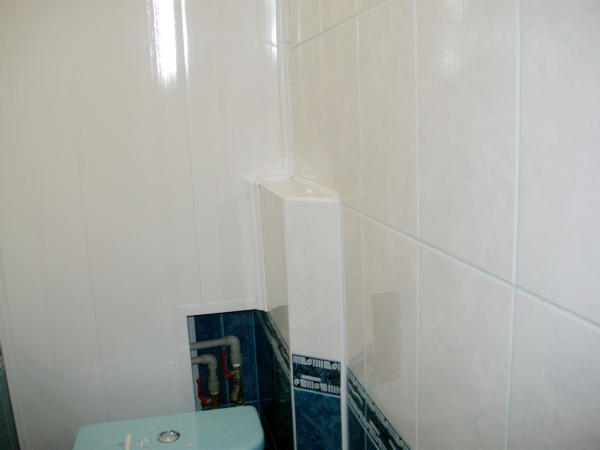

Photo 2. A box made of plastic panels that covers the sewer and water pipes in the toilet.
In this case, no special frame for plastic panels was made; 2 wooden blocks and 1 more block on the ceiling were fixed to opposite walls with the help of metal corners:
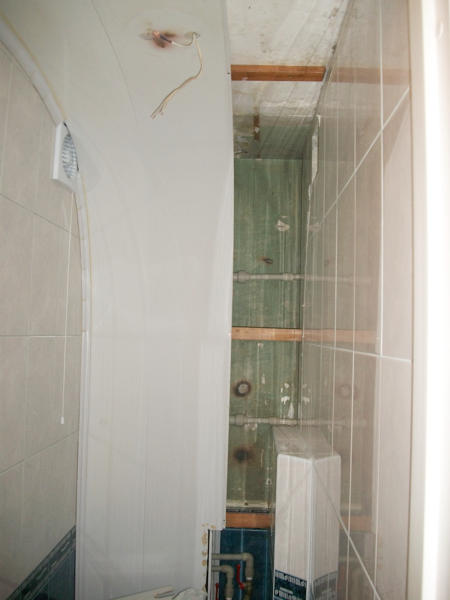

Photo 3... Arrangement of timber frame bars for plastic panels.
In this case, both the ceiling and the wall were immediately finished with plastic panels, for this the panels were bent and therefore the bars could be placed at a great distance. And in photo 3 you can see how the plastic burns out when you attach an overhead lamp with ordinary incandescent bulbs to it. The fact is that the plastic panels have already been removed to repair the water pipes and the photo shows the process of re-installing the plastic panels.
Installation of an invisible hatch
To provide access to pipes with a plasterboard structure, you can use a ready-made plastic door or make a disguised opening panel consisting of an aluminum frame, a door, a magnetic lock, a structure of hinges and knots.
An inconspicuous door (invisible hatch) installed in the wall will allow you to easily check the water readings, turn off the valve, and also assess the condition of the pipes
In order to open the invisible hatch, it is enough to press on its middle, after which the magnetic lock snaps off, releasing the door from the frame.
The hatch is installed as follows:
- Even at the preliminary stage, you should decide on the location of the door. Usually it is located in the center of the box or partition, which makes it possible to better maintain the symmetry of the pattern when tiling.
- When installing the frame, it is important to leave a niche (on two or four sides), the size of which corresponds to the parameters of the hatch. After its construction, the frame is attached to the profiles using long self-tapping screws (special holes are provided for them). According to the instructions supplied with the kit, the door and other parts of the hatch are attached to the frame.
- Next, the frame is covered with plasterboard sheets, which are overlapped and overlapped on the hatch frame (it should also be attached to the coating with self-tapping screws).
- Upon completion of the stage of work, drywall and the door are covered with a layer of primer. After drying, the hatch and box are covered with tiles (one-color or patterned). All joints between the tiles are covered with a sealant, after which the structure is left alone for two days for final drying.
The final stage is cutting the hatch, which is performed using a sharp stationery knife directed at an angle of 45 degrees.
Material selection
Before making pipes into a box in the bathroom, you need to decide on its design and choose the right material.
The latter must meet the following requirements:
- be resistant to moisture;
- have little weight;
- be environmentally friendly and do not emit substances that are harmful to human health.
Most of these criteria are met by plastic, however, you can also use moisture-resistant drywall, plywood or MDF. If price is the determining factor for you when choosing a material, then you should not even look for a better option than this or that type of plastic.
Photo of a plastic box
Advice! To provide free access to the pipes in the event of a breakthrough, it is advisable to make a collapsible box. Otherwise, you will have to destroy the structure to fix the breakage.
Useful tips for the device
When arranging a structure, it is important to take into account the following recommendations of specialists:
- If the box is intended for masking vertical pipes, the marking should be carried out starting from the floor.
- It is imperative to provide a door or hatch at the valve and water meter.
- Regardless of the material used for the device of the system, an antifungal agent must be applied to its inner surface to protect it from harmful microorganisms.
- In a bathroom with a high vapor content, it is highly advisable to avoid wooden structures: in this case, a metal profile should be preferred.
- For the device of the box, it is impractical to use various types of chipboard, including waterproof plates, since this material swells under the influence of water vapor.
- When fastening the structure to the ceiling, the cross pieces are spaced 30 centimeters apart to ensure the proper rigidity of the structure.
- With closely spaced pipes, it is better not to build separate boxes around each of them, but to create a single structure for the entire communication system.
It is important to make sure that the box does not touch the communications: the minimum distance of the sheathing from the pipe should be 3 centimeters.
Roller shutters can be an alternative to the partition box. They give the interior a stylish look and also provide full access to the piping.
We mount the box in the bathroom
The choice of material for the box is not critical.


Before proceeding with the installation of the box in the bathroom, you should watch the video and study the advice of experts
It is recommended to pay attention to moisture-resistant materials, which will create a very durable structure, especially if a massive decorative finish is planned.
You can make a box in the bathroom with your own hands, and even a beginner can do such work. It is important to make calculations in advance and prepare the necessary material. The main condition that should be met when working independently is that the lined box should not touch the pipes.
There are several options for the design of the box:
- Plastic... Plastic panels are gaining popularity due to their low price, but for work it is worth purchasing additional wooden blocks, screws, profiles, baseboards. Bars are attached to the wall according to the pre-prepared markings with self-tapping screws. It is important to anchor the bars in the center of the structure. The profile and skirting boards are attached with a special construction stapler, and at the end they are inserted one by one into the grooves in the panels. No decorative trim needed.
- Plasterboard... Plasterboard boards are installed on a metal frame with self-tapping screws. Further, decorative finishing is carried out.
- Cupboard... The box will hide the pipes, but it will take up some useful space and, in order not to lose it, you can build a structure in the form of a cabinet.
As a material for the cabinet, you can use drywall. The required number of shelves is installed inside. Cabinet doors can be ordered separately, they can be made of a mirror.

